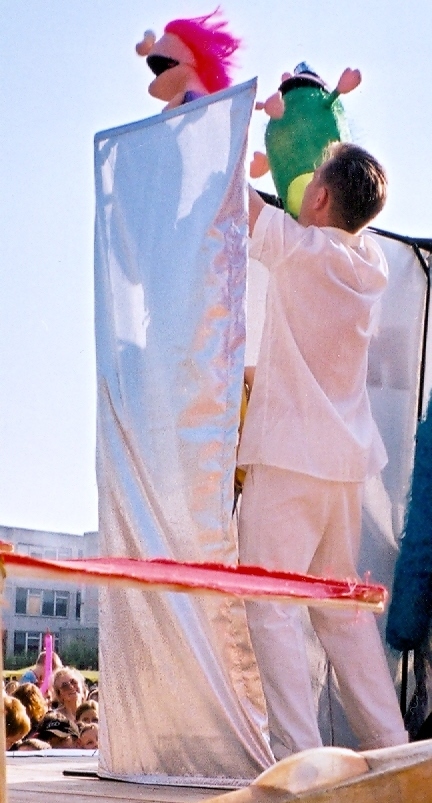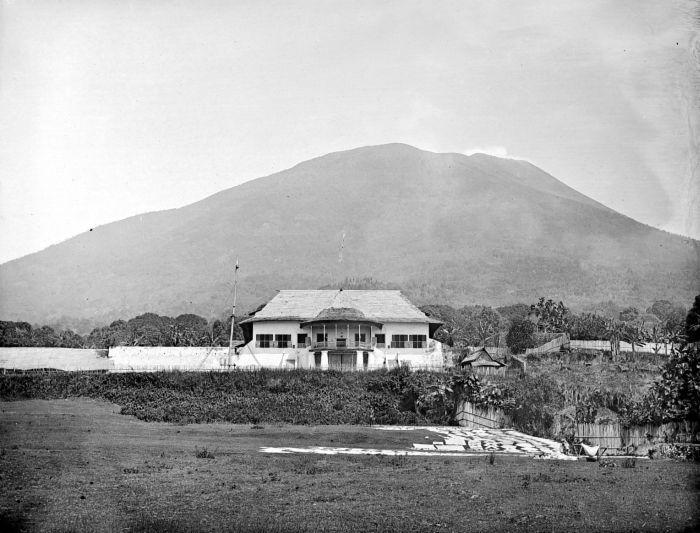|
Dhalang
The dhalang or dalang ( jv, dhalang; id, dalang) is the puppeteer in an Indonesian ''wayang'' performance. In a performance of ''wayang kulit'', the dalang sits behind a screen (''kelir'') made of white cotton stretched on a wooden frame. Above his head, hanging from beams attached to the top of the screen, is the lamp (''blencong''), which projects the shadows onto the screen. In front of the dhalang is a stage (''debog''), traditionally made from the trunk of a banana tree, into which the sharpened control rods of the puppets can be pushed to keep them in position during the performance. To his left is the puppet chest (''kotak''), and to his right is the puppet chest's lid, on which the puppets sit ready for use. In addition to moving the puppets and speaking their lines, the dalang is also responsible for giving cues to the gamelan. This is done principally by playing the kepyak, a metal plate or set of plates played with his foot, or by rapping on the puppet chest (''kotak' ... [...More Info...] [...Related Items...] OR: [Wikipedia] [Google] [Baidu] |
Wayang Performance
, also known as ( jv, ꦮꦪꦁ, translit=wayang), is a traditional form of puppet theatre play originating from the Indonesian island of Java. refers to the entire dramatic show. Sometimes the leather puppet itself is referred to as . Performances of wayang puppet theatre are accompanied by a ''gamelan'' orchestra in Java, and by ''gender wayang'' in Bali. The dramatic stories depict mythologies, such as episodes from the Hindu epics the ''Ramayana'' and the ''Mahabharata'', as well as local adaptations of cultural legends. Traditionally, a is played out in a ritualized midnight-to-dawn show by a ''dalang'', an artist and spiritual leader; people watch the show from both sides of the screen. performances are still very popular among Indonesians, especially in the islands of Java and Bali. performances are usually held at certain rituals, certain ceremonies, certain events, and even tourist attractions. In ritual contexts, puppet shows are used for prayer rituals (held in ... [...More Info...] [...Related Items...] OR: [Wikipedia] [Google] [Baidu] |
Puppeteer
A puppeteer is a person who manipulates an inanimate object, called a puppet, to create the illusion that the puppet is alive. The puppet is often shaped like a human, animal, or legendary creature. The puppeteer may be visible to or hidden from the audience. A puppeteer can operate a puppet indirectly by the use of strings, rods, wires, electronics or directly by his or her own hands placed inside the puppet or holding it externally or any other part of the body- such as the legs. Some puppet styles require two or more puppeteers to work together to create a single puppet character. The puppeteer's role is to manipulate the physical object in such a manner that the audience believes the object is imbued with life. In some instances, the persona of the puppeteer is also an important feature, as with ventriloquist's dummy performers, in which the puppeteer and the human figure-styled puppet appear onstage together, and in theatre shows like ''Avenue Q''. The puppeteer might speak ... [...More Info...] [...Related Items...] OR: [Wikipedia] [Google] [Baidu] |
Wayang
, also known as ( jv, ꦮꦪꦁ, translit=wayang), is a traditional form of puppet theatre play originating from the Indonesian island of Java. refers to the entire dramatic show. Sometimes the leather puppet itself is referred to as . Performances of wayang puppet theatre are accompanied by a ''gamelan'' orchestra in Java, and by '' gender wayang'' in Bali. The dramatic stories depict mythologies, such as episodes from the Hindu epics the ''Ramayana'' and the ''Mahabharata'', as well as local adaptations of cultural legends. Traditionally, a is played out in a ritualized midnight-to-dawn show by a ''dalang'', an artist and spiritual leader; people watch the show from both sides of the screen. performances are still very popular among Indonesians, especially in the islands of Java and Bali. performances are usually held at certain rituals, certain ceremonies, certain events, and even tourist attractions. In ritual contexts, puppet shows are used for prayer rituals (held in ... [...More Info...] [...Related Items...] OR: [Wikipedia] [Google] [Baidu] |
Sulukan
''Sulukan'' normally refers to mood setting songs by a puppeteer ''(dhalang)'' in Javanese people, Javanese ''wayang'' ("puppet") performances in Indonesia. The term can also refer to the pathetan pieces played before and after ''gamelan'' pieces in a non-wayang context, and to mystical poetry relating to the doctrinal meaning of the term ''sulook''. Etymology The etymology of the term is unclear. Arps relates it to the ''gamelan'' practice of ''cêluk'' ("calling out"), an introduction to a piece with a sung phrase, rather than an instrumental introduction.Arps (1992) It is also possible that the word derives from the Sanskrit term ''sloka meter, sloka'', a verse form consisting of octosyllabic couplets. This is plausible considering that the metrical structure of ''sulukan'' verses does indeed generally conform to the pattern of octosyllabic couplets, the etymology may have passed into Javanese lore from the work of 19th century Dutch scholars. This verse form is in sharp contra ... [...More Info...] [...Related Items...] OR: [Wikipedia] [Google] [Baidu] |
Wayang
, also known as ( jv, ꦮꦪꦁ, translit=wayang), is a traditional form of puppet theatre play originating from the Indonesian island of Java. refers to the entire dramatic show. Sometimes the leather puppet itself is referred to as . Performances of wayang puppet theatre are accompanied by a ''gamelan'' orchestra in Java, and by '' gender wayang'' in Bali. The dramatic stories depict mythologies, such as episodes from the Hindu epics the ''Ramayana'' and the ''Mahabharata'', as well as local adaptations of cultural legends. Traditionally, a is played out in a ritualized midnight-to-dawn show by a ''dalang'', an artist and spiritual leader; people watch the show from both sides of the screen. performances are still very popular among Indonesians, especially in the islands of Java and Bali. performances are usually held at certain rituals, certain ceremonies, certain events, and even tourist attractions. In ritual contexts, puppet shows are used for prayer rituals (held in ... [...More Info...] [...Related Items...] OR: [Wikipedia] [Google] [Baidu] |
Sulukan
''Sulukan'' normally refers to mood setting songs by a puppeteer ''(dhalang)'' in Javanese people, Javanese ''wayang'' ("puppet") performances in Indonesia. The term can also refer to the pathetan pieces played before and after ''gamelan'' pieces in a non-wayang context, and to mystical poetry relating to the doctrinal meaning of the term ''sulook''. Etymology The etymology of the term is unclear. Arps relates it to the ''gamelan'' practice of ''cêluk'' ("calling out"), an introduction to a piece with a sung phrase, rather than an instrumental introduction.Arps (1992) It is also possible that the word derives from the Sanskrit term ''sloka meter, sloka'', a verse form consisting of octosyllabic couplets. This is plausible considering that the metrical structure of ''sulukan'' verses does indeed generally conform to the pattern of octosyllabic couplets, the etymology may have passed into Javanese lore from the work of 19th century Dutch scholars. This verse form is in sharp contra ... [...More Info...] [...Related Items...] OR: [Wikipedia] [Google] [Baidu] |
Javanese Culture
Javanese culture is the culture of the Javanese people. Javanese culture is centered in the provinces of Central Java, Yogyakarta and East Java in Indonesia. Due to various migrations, it can also be found in other parts of the world, such as Suriname (where 15% of the population are of Javanese descent), the broader Indonesian archipelago region, Cape Malay, Malaysia, Singapore, Netherlands and other countries. The migrants bring with them various aspects of Javanese cultures such as music, traditional dances and art of shadow play. The migration of Javanese people westward has created the coastal Javanese culture that is distinct from inland Sundanese culture in West Java and Banten. Being the largest ethnic group, the Javanese culture and people influence Indonesian politics and culture, a process sometimes described as Javanisation. Literature Javanese literature tradition is among the earliest and the oldest surviving literature traditions in Indonesia. The transla ... [...More Info...] [...Related Items...] OR: [Wikipedia] [Google] [Baidu] |
Indonesian Institute Of The Arts, Yogyakarta
, native_name_lang = jv , image = , image_size = , caption = , latin_name = Institutum Indonesia de Ars: Yogyakarta , other_name = ISI Yogyakarta, ISI Jogja , motto = , established = July 23, 1984 , type = Public , city = Bantul , state = Special Region of Yogyakarta , country = Indonesia , undergrad = 5,591 (2020) , postgrad = 280 (2020) , postgrad_label = , rector = Prof.Dr. M. Agus Burhan, M.Hum , faculty = 329 lecturers , coordinates = , campus = Suburban , free_label = , free = , colours = Light Steel Blue , mascot = Sarasvatī सरस्वती , logo = , logo_size = 250px , website = , footnotes = The Indonesia Institute of the Arts, Yogyakarta (''Institut Seni Indonesia Yogyakarta'', ISI Yogyakarta) is a state-owned college in Bantul Regency, Special Region of Yogyakarta, Indonesia. It teaches visual, performing, and media arts in traditional Indonesian and modern international styles. ISI Yogyakarta was ranked number one in Indone ... [...More Info...] [...Related Items...] OR: [Wikipedia] [Google] [Baidu] |
Kraton (Indonesia)
Kraton or keraton ( jv, ꦏꦿꦠꦺꦴꦤ꧀ or ꦏꦼꦫꦠꦺꦴꦤ꧀) is a type of royal palace in Java, Indonesia. Its name is derived from the Javanese ''ka-ratu-an'', meaning residence of the ''ratu'', the traditional honorific title for a monarch. In Java, the palace of a prince is called ''pura'' or ''dalem'', while the general word for palace is ''istana'', identical to Malay. Specific palaces Kraton that function as the residence of a royal family include: ;Yogyakarta (Jogja) region: * Kraton Ngayogyakarta Hadiningrat (Palace of Sultan Hamengkubuwono). * Pura Pakualaman (Palace of Adipati Pakualam). ; Surakarta (Solo) region: * Kraton Surakarta Hadiningrat (Palace of Susuhunan Pakubuwono). *Pura Mangkunegaran (Palace of Adipati Mangkunegara). ;Cirebon area: *Kraton Kasepuhan (Palace of Sultan Sepuh). *Kraton Kanoman (Palace of Sultan Anom). *Kraton Kacirebonan (Palace of Sultan Cirebon). *Kraton Kaprabonan ( id) (Palace of Sultan Prabon). Historical palaces T ... [...More Info...] [...Related Items...] OR: [Wikipedia] [Google] [Baidu] |
Yogyakarta
Yogyakarta (; jv, ꦔꦪꦺꦴꦒꦾꦏꦂꦠ ; pey, Jogjakarta) is the capital city of Special Region of Yogyakarta in Indonesia, in the south-central part of the island of Java. As the only Indonesian royal city still ruled by a monarchy, Yogyakarta is regarded as an important centre for classical Javanese fine arts and culture such as ballet, ''batik'' textiles, drama, literature, music, poetry, silversmithing, visual arts, and '' wayang'' puppetry. Renowned as a centre of Indonesian education, Yogyakarta is home to a large student population and dozens of schools and universities, including Gadjah Mada University, the country's largest institute of higher education and one of its most prestigious. Yogyakarta is the capital of the Yogyakarta Sultanate and served as the Indonesian capital from 1946 to 1948 during the Indonesian National Revolution, with Gedung Agung as the president's office. One of the districts in southeastern Yogyakarta, Kotagede, was the capital of t ... [...More Info...] [...Related Items...] OR: [Wikipedia] [Google] [Baidu] |







